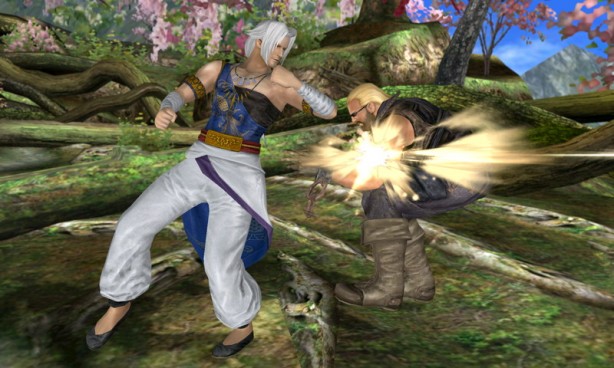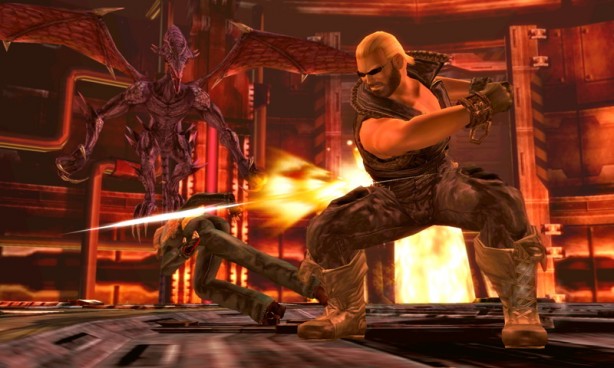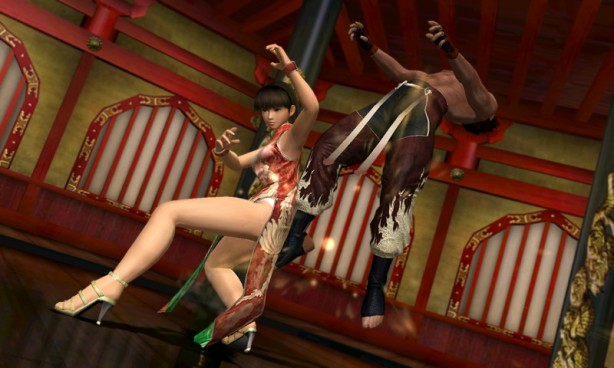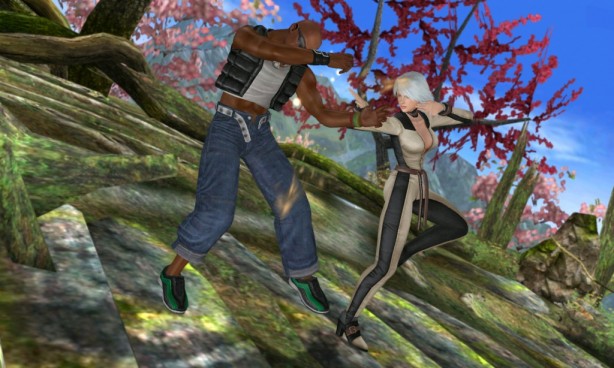Dead Or Alive: Dimensions Review
 Game: Dead or Alive: Dimensions
Game: Dead or Alive: Dimensions
Developer: Tecmo Koei
Publisher: Team Ninja
Available on: Nintendo 3DS only
You wait years for a decent fighter to come out on a handheld console, and then two blinders come along at once. Yessir, I guess you would have to go back to early PSP titles such as Tekken: Dark Resurrection and Street Fighter Alpha Max or the days of the ill-fated yet undeniably cool Neo Geo Pocket for the last decent one-on-one dust-up you could play on the comfort of the khazi. Consequently, with the Nintendo 3DS barely out of nappies, it is pleasing to see that it is already home to two highly playable, excellently realised installments of classic fighting franchises. And one of them has 3D tits, you say?
STORY: Tecmo’s Team Ninja-developed Dead Or Alive fighting series has always lived in the shadows of higher profile cousins such as Tekken, Virtua Fighter and (of course) Street Fighter. But it is unfair to label DOA inferior. With an emphasis on fast-paced action, landing accurate strikes on your opponent and countering their moves with an excellent reversal system, there have been some awesome DOA games over the years since its inception way back in 1996. Dead Or Alive 3 was a proper online riot and highly popular for the Microsoft Xbox. Dead Or Alive 4 continued the tradition of superb, brisk action and its gameplay also translated brilliantly into online battles, even if it was pretty much ignored by Xbox 360 owners.

As the god-awful 2006 live action movie demonstrates with mind-numbing clarity, the DOA plots have always been a pile of old bollocks. Generally, the storyline will involve the sinister Dead Or Alive Tournament Executive Committee organising a fighting tournament in a series of exclusive locales around the world, all the while hatching some dastardly plan straight out of a rubbish Bond film. Dead Or Alive: Dimensions attempts to incorporate a storyline that ties up the events of the previous games in the series, introducing both back stories and wild plot tangents by means of cut-scenes interspersed throughout the action. As with most games where your singular aim is to leather the bejaysus out of someone until they don’t stand up any more, the introduction of such narrative tomfoolery is largely irrelevant.
Apart from Tecmo mascot and Ninja Gaiden mainstay Ryu Hayabusa, DOA lacks a single identifiable, iconic character; there is no Ryu (of the Street Fighter variety), or Terry Bogard here. What it does possess are a number of what some would deem highly attractive female combatants, all endowed with what some would describe as tremendous, erm, orbs of joy, something that explains why Team Ninja have all but abandoned the canonical fighting sequels for the last six years, concentrating instead on making awful beach-based volleyball mini-game compilations, starring the ladies of DOA wearing dental floss thongs.
Given the high quality of DOA’s fighting game output, it is a shame that it has taken so long for Team Ninja to pull their finger out and deliver another. But it is very pleasing to announce that Dead Or Alive: Dimensions is certainly worth the wait, and is a timely reminder that beat ’em up fans should not sleep on this highly satisfying series.
GRAPHICS: Without wishing to lazily compare what are effectively two very different games, it is fair to say that whilst DOA:D is a good-looking game, it suffers in comparison to Capcom’s far prettier Super Street Fighter IV 3D in the visuals department. That isn’t to say that the slick 3D characters and pretty backdrops here aren’t impressive, mind. The action whizzes by at a speedy 60 frames per second with the 3D turned off; turn on the 3DS’ slider of graphical trickery and the frame rate splits to 30 fps for each eye, and whilst this is not as smooth, the depth added by the stereoscopic magic is impressive and does not detract from the action.
There are 25 characters to play around with, including twelve mightily stacked bits of martial arts crumpet. Whilst the fighters lack the individuality, charm and familiarity of their Capcom counterparts, there is variety in their design and they are well-rendered on the little Nintendo screen. There is an impressive selection of backgrounds, most of which are interactive in some way, and it is a great thrill seeing the superb cut-away effects when you throw your opponent over a cliff or pick them up and leg it down a snowy incline before power-bombing them into the ground.
Nintendo fanboys are also likely to wet their pants with joy when they discover that one cracking-looking stage is based upon Metroid: Other M and features Samus’ arch nemesis Ridley peppering the arena with fireballs. The in-game graphics all look great, but there is also also a superb intro/attract mode which introduces you to the proceedings and some nice cut-scenes and end sequences which punctuate Chronicle Mode and bookend the action.

SOUND: You get your various grunts, yelps, and screams as par for the course; each character also has a selection of stock, fairly unimaginative taunts and phrases that are used before and after they have stoved someone’s heed in. Tecmo Koei have included the option to retain the original Japanese voices (with subtitles in both English AND Japanese kanji), which is always nice and somehow lends an air of martial arts authenticity to braying people to within an inch of their life. The whole thing is held together with some inoffensive music that chugs along nicely. Basic fighter fare really, and there are no major complaints from this quarter.
GAMEPLAY: The fighting mechanics in DOA:D are absolutely top-drawer. For those of you unfamiliar with the series, Team Ninja have always placed an emphasis on nimble footwork, juggles and well-timed counter moves. There is no leaping through the air here – your character remains on the deck for the most part and can circumnavigate their opponent. Controls are kept very simple with one kick and one punch button, and one button each for block or throw. Special moves are simplified mainly by moving the d-pad or analogue stick in a particular direction and combining this with the attack button.
There are very few intricate circular movements required as in SFIV, and combos are usually achieved by pressing a series of buttons in sequence. Helpfully, these are listed on the touch screen and can be used during battle by touching them, although this can be a little awkward during real-time fights. The brilliant reversal/counter attack system is all about patience and timing, in particular anticipating your opponent’s next move and using the appropriate counter technique in response. This means that more observant, patient players are richly rewarded and will triumph over a kamikaze button-basher more often than not.
Another nice touch is something that has been a constant feature throughout the series, the use of the scenery to more effectively wound your foe. The backdrops have key areas that can be interacted with during a fight; as mentioned previously you can throw people from a great height (incurring additional damage), hoist someone onto your shoulder and run down a hill with them to build up momentum for a throw attack, or just simply bash their brains in against a wall.
There are a variety of gameplay modes. Chronicle attempts to incorporate the often confusing DOA saga in a lengthy, cut-scene peppered five-chapter story mode. Switching between various characters and offering handy tutorials as you progress, Chronicle is a good way to familiarize yourself with the DOA universe, whilst showing you some useful techniques along the way.
Arcade mode does what it says on the tin, with a slight twist. Rather than a straight-up set number of fights with a predetermined difficulty selected, Arcade features a number of increasingly more difficult “courses”, with unlockables to pick up along the way, such as initially locked-out additional characters and trophies (of which more later). Your Arcade mode course times are also recorded so that you can go back and have a crack at beating them.

There is another mission-based mode, Tag Challenge, which borrows the popular tag team element from DOA4 and pits you and an AI-controlled opponent in a two-on-two throw-down against a series of badass duos. Excellently, you can also team up with a buddy on wi-fi in this mode, and whilst it would have been nice to be able to have online competitive tag team brawls, the Tag Challenge mode is a corker. These three ace game modes are complimented by an endless Survival mode, a Training mode, and the option to engage in Free Play against the opponent of your choice.
Unfortunately, for all of the killer single player shizzle on offer, DOA:D is unable to provide an equally satisfactory online gaming experience. Getting into a lobby and challenging a denizen of the interweb is easy enough, but sadly the frame rate goes tits-up (no pun intended) when playing online, even over local wi-fi which renders the normally stellar ninjitsu ‘n’ jugs action near unplayable. There is an improvement if you turn off the 3D, but this is a compromise that you should not need to make, given that you have bought the damn console with the not unreasonable expectation of the full 3D experience at all times.
LONGEVITY: This is a fully-loaded release, the Chronicle mode is a good seven or eight hours if you go right through it in detail, and the arcade mode will keep you coming back for more to improve on your times. It is not particularly difficult to unlock all of the characters, however the inclusion of a thousand collectible character trophies will satisfy the obsessive compulsive fight fan no end. There is the curious addition of the Showcase mode, which gives you the opportunity, should you wish, of creating what Team Ninja describe as “epic dioramas” of your collected character figurines, and then taking pictures of them in various poses. This may sound a bit twee, but affords us the long-awaited ability to create a Kodak moment of Hayabusa goosing Kasumi against the backdrop of a spooky, gnarled ancient tree.
Streetpass is also put to use and adds another reason to keep persevering with DOA:D: the game very cleverly builds up a profile for you based upon your play style and technique. Further to this, the Throwdown mode, when engaged, will send your character to any fellow DOA-er you pass in the street and allow them to engage in fisticuffs with a unique AI representation of your Dead Or Alive skill (or lack thereof).

VERDICT: Nintendo 3DS, with this bounty of super-duper brawlers, you are really spoiling us. Aye, this is another cracking fighter, making the stereoscopic wonder 2 for 0 on the beat ’em up front, and tantalising us with the prospect of Arc System Works’ next move into the territory with what looks like another sterling installment of Blazblue. It is a good time to be a fighting fan, and although you could reasonably argue that DOA:D and Street Fighter are the two stand-out games for the format, it is early days yet.
Dead or Alive nails the controls beautifully, plays like a dream and has loads of stuff to see and do. Look past the slightly inferior visuals and the inevitable differences in character quality, because were it not for the dodgy online mode (something that in this day and age a beat ’em up stands or falls by), this would be easily the equal of Capcom’s grade-A 3DS debut. Here’s hoping that Team Ninja recognise this, and go on to push things forward with their excellent one-on-one product, rather than serve up unwanted breast-themed nonsense that would barely titillate a randy thirteen year old.





